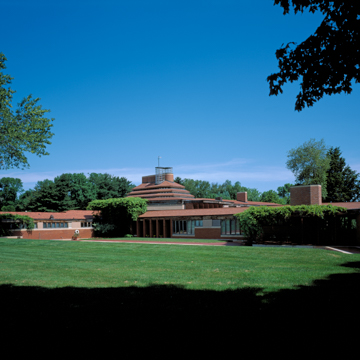The largest residence Wright ever built and, according to Wright, the best-constructed, this sprawling house was created for Johnson Wax president Herbert Fisk Johnson Jr. and his family. Wright named the house Wingspread, because its four long wings radiate, pinwheel-like, from an octagonal hub. Originally each wing was zoned for a distinct function—master bedroom suite in one wing, children’s rooms and play area in a second, kitchen and servants’ quarters in the third, guest rooms and carports in the fourth, and living and dining spaces at the hub. The wings also define four landscape zones: a swimming pool, a garden and grape arbor, a driveway, and a terraced lawn tumbling down to a pond and a meandering ravine beyond.
In all his houses, Wright took design cues from the natural landscape. Here, he emphasized low, horizontal lines to harmonize the house with its gently rolling site near Lake Michigan. He faced the walls with smooth red brick near the ground and ran lapped cypress siding and long window ribbons higher up. He stretched the horizontal even further by surrounding the house with low garden walls and most dramatically by cantilevering a sitting room from the end of the two-level master bedroom wing. As these traits are hallmarks of the Prairie Style, Wright often called Wingspread his last Prairie house.
At the hub, where the wings converge, curving lines and elliptical shapes hint at one of the most spectacular indoor spaces Wright ever created. In an enormous, thirty-foot-high central living area that Wright called the wigwam, light pours in through a three-tiered clerestory, wrapping around the ceiling, and through soaring glass doors on every side. A giant elliptical chimney, with four hearths around its base and a fifth on a mezzanine level, rises through the wigwam center. More zoned spaces—a foyer, dining area, great hall, library, and music alcove—flow around the chimney base, separated by built-in furniture and shifts in floor and ceiling level. Overhead, stairs spiral from the mezzanine to a glass-enclosed tower, offering vistas of the landscape and the distant lake.
Herbert Johnson donated Wingspread to the Johnson Foundation in 1959, and it became a conference center. The rooms in the wings were remodeled and the carport walled in, but the stunning wigwam remains virtually unchanged, a witness to Wright’s mastery of form and space.
Wingspread’s neighbor, the low-slung, red brick Prairie School (1965) designed by Taliesin Architects at 4050 Lighthouse Drive, houses a private K-12 school and features a series of interconnected buildings designed in a circular motif that follow the natural topography of the site.





















